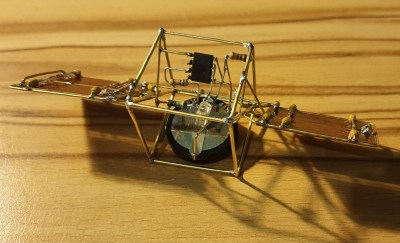They say that imitation is the sincerest form of flattery. If we were going to imitate one of master circuit sculptor Mohite Bhoite’s creations, we’d probably pick the little blinky solar satellite as a jumping off point just like [richardsappia] did. It’s cute, it’s functional, and it involves solar power and supercapacitors. What more could you want?
 SATtiny is a pummer, which is BEAM robotics speak for a bot that soaks up the sun all day and blinks (or ‘pumms’, we suppose) for as long as it can throughout the night on the juice it collected. This one uses four mini solar panels to charge up a 4 F supercapacitor.
SATtiny is a pummer, which is BEAM robotics speak for a bot that soaks up the sun all day and blinks (or ‘pumms’, we suppose) for as long as it can throughout the night on the juice it collected. This one uses four mini solar panels to charge up a 4 F supercapacitor.
At the controls is an ATtiny25V, which checks every eight seconds to see if the supercapacitor is charging or not as long as there is enough light. Once night has fallen, the two red LEDs will pumm like a pair of chums until the power runs out. Check out the brief demo after the break.
Would you rather have something more nightstand-friendly? Here’s a mini night light sculpture with a friendly glow. If you haven’t started your entry into our Circuit Sculpture Challenge, there’s still plenty of time — the contest runs until November 10th.















I wonder if it really would work in space?
I don’t think so, because of solar wind or charged particules which shall certainly destroy the MCU in space
I think you’re wrong about that. While some chips seem to have some trouble with the radiation levels and charged particles whizzing through, it is the older ones with “coarse” features that are most resistant to the harsh environment in space. So the relatively old technology that is the basis of the attinies is likely to stand up.
Stuff like high density DRAM in a raspberry pi will suffer from bit-flips due to the charged particles flying by…. Turns out raspberry pies work just fine in space.
Maybe the FLASH memory won’t stand up the “guaranteed 30 years at 25C”, If it would be 30x less, that would still count as a “works in space” to me.
This topic is being addressed already here :
https://twitter.com/RSFlightronics/status/1300777973780566016?s=19
Nice an pretty build. It would be interesting to replace supercap with LIR2032, that would increase storage capacity for 10+ times and make the sculpture much more energy independant as even cloudy days could provide 30-40 mAh to charge LIR fully. Supercap with 4F can store around 1/10 of that energy and has higher self-discharge.
But you do know there’s plenty of solar garden lights on the market?
All of the garden lights I’ve seen have rechargable cells that die easily. So any work in this direction is interesting to me.
Yeah, it seems most garden lights are built to the lowest possible cost (therefore, quite common in Dollar stores).
I would like to buy more durable garden lights, but I wonder if even the expensive ones (more elaborate housings) are built with such cheap electronics.
I wish to add, that I suppose it is the same with replacement batteries…
There are so many cheapies out there, even if I were to pay 4 times as much, would I be getting the same (relabeled) crap ?
If only the garden light market could support the marginal cost of a black blob IC with some minimal intelligence to turn off after 4 hours (leave some power for the next night, avoid daily 100% discharge), blinky, flame flicker, different colors, etc. But that is what this project addresses… And the SuperCap, while small in capacity, should last a lot longer than any rechargeable battery could. The ornamental and charge management concept demonstrated is universal. Thanks for sharing.
Seems like an ideal application for the old LM3909, if it was still being produced. I wonder how the power consumption would compare to the modern microcontroller way of doing everything…
LM3909 was pretty clever. Used bi-polar transistors so not as efficient as CMOS. Drew on average 300-500uA to flash an LED.
Nice to see BEAM robots again. There’s so many incredible robotics projects lost to the early web (mine included) and we have high capacity batteries, better solar panels and smaller more capable controllers BEAM robotics could make a comeback in a big way.
Lost? But Wayback Machine, no?
(web.archive.org)
Start a project at hackaday.io and highlight some of these incredible ur projects?
Would like to build one. Can you please help?
Can it be done with a LI-ION battery??, I understand with li-ion battery we need to take certain precautions